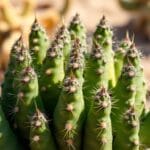Ever wondered why the Old Lady Cactus is called “old lady”? This cute succulent has a furry white coat. It’s full of life and easy to care for. Let’s explore Mammillaria hahniana and see why it’s loved by many.
The Old Lady Cactus, or Mammillaria hahniana, is small but mighty. It comes from Mexico and grows up to 4 inches tall and 8 inches wide. It’s great for small spaces1. Its white spines make it look like a snowball, earning it its nickname.
This cactus looks delicate but is quite tough. It loves well-draining soil and warm places. It does well outside in hot weather and inside as a houseplant. It’s perfect for both new and experienced plant lovers.
The Old Lady Cactus blooms in late winter to early spring. It shows off funnel-shaped, hot pink flowers with yellow anthers1. These bright flowers add color to any collection and show that the cactus is happy and healthy.
Key Takeaways
- Old Lady Cactus is native to Mexico and thrives in warm climates
- It’s known for its fuzzy white appearance and pink flowers
- This cactus is suitable for both indoor and outdoor growing
- It’s an excellent choice for beginners and experienced growers
- Proper care includes well-draining soil and moderate watering
- Flowering typically occurs in late winter to early spring
Introduction to the Old Lady Cactus
The Old Lady Cactus, also known as Mammillaria hahniana, is a favorite among cactus lovers. It’s part of the Mammillaria genus, which has 147 accepted species2.
Origin and Native Habitat
Coming from Central Mexico’s tough terrains, the Old Lady Cactus shows nature’s strength3. Mammillaria species stretch from the United States to Colombia, proving they can thrive in many climates2.
Unique Characteristics and Appearance
The Old Lady Cactus is a standout with its rounded shape and fuzzy look. It can grow up to 10 inches tall and 20 inches wide, making impressive mounds as it grows3. Its stems are covered in short, white spines, making it feel soft to the touch.
Why It’s a Popular Choice for Cactus Enthusiasts
Cactus fans love the Old Lady Cactus for many reasons:
- It’s easy to care for
- It looks unique and beautiful
- There are many varieties to choose from
- It blooms with stunning flowers
In late winter to early spring, the Old Lady Cactus blooms with funnel-shaped flowers. These can be white, pink, or yellow, with a darker stripe in the middle2.
| Feature | Description |
|---|---|
| Height | Up to 10 inches |
| Width | Up to 20 inches |
| Flower Colors | White, pink, yellow |
| Native Region | Central Mexico |
The Old Lady Cactus is loved for its beauty and easy care. It’s a top pick for those wanting to add a bit of Mexican flair to their plant collection.
Understanding Mammillaria hahniana
The Old Lady Cactus, also known as Mammillaria hahniana, is a special cactus. It’s loved by many for its unique looks and how it grows. It’s a favorite among those who enjoy taking care of houseplants.
Taxonomy and Classification
Mammillaria hahniana is part of the Mammillaria family, with 138 species recognized by December 20234. It comes from central Mexico, found in Queretaro, Hidalgo, San Luis Potosí, and Guanajuato45. It loves to grow on steep slopes in forests and matorral.
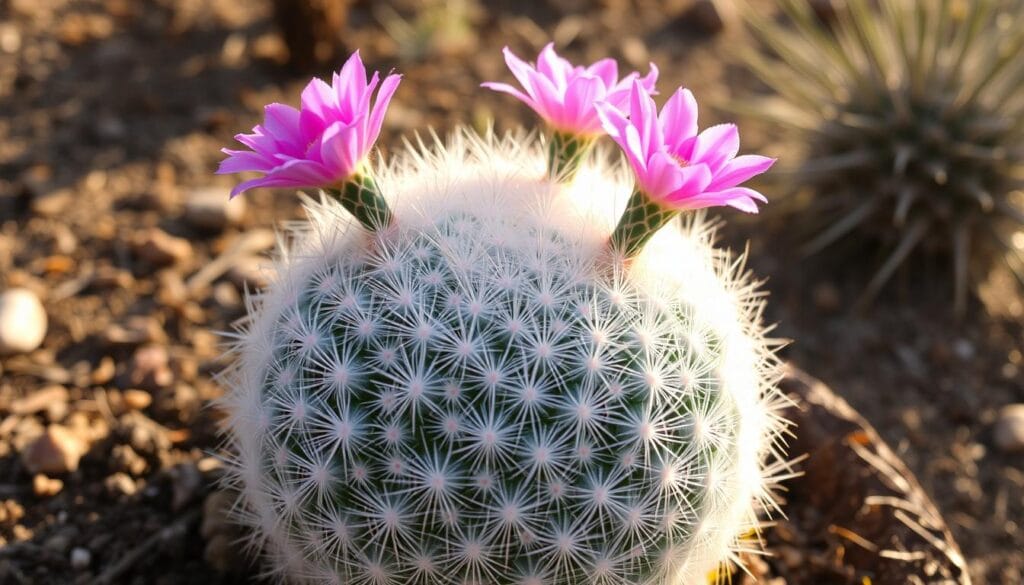
Growth Habits and Mature Size
The Old Lady Cactus grows slowly and forms clusters. It can get up to 25 cm tall and 50 cm wide6. Its stems can be 12 cm in diameter6. As it grows, its wool gets thicker and longer4.
Lifespan and Development Stages
With good care, the Old Lady Cactus can live 20 to 30 years, and sometimes longer5. It goes through different stages:
- Seedling stage: It starts growing from a seed
- Juvenile stage: It gets its woolly look
- Mature stage: Around 10 years old, it blooms with pink or purple flowers5
This cactus is known for its beauty and toughness. It even got the Royal Horticultural Society’s Award of Garden Merit6. Its long white hair and dense wool make it a favorite among cactus lovers4.
Ideal Growing Conditions for Old Lady Cactus
The Old Lady Cactus is a remarkable succulent that loves specific conditions. It comes from Central Mexico, where it’s used to warm, dry places3.
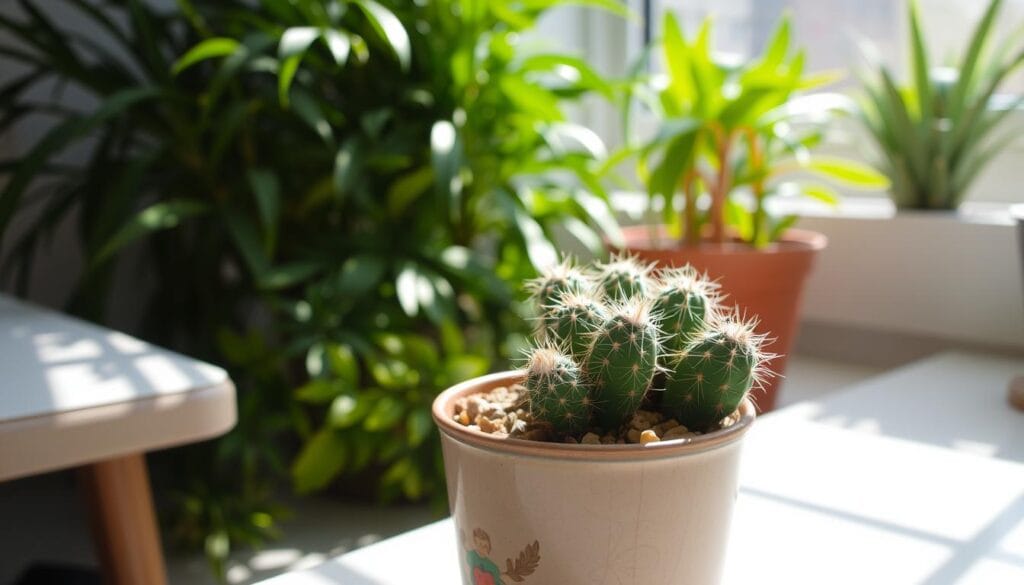
For the best care, put your Old Lady Cactus in a bright spot. It needs 4 to 6 hours of direct sunlight each day to grow well1. If you’re growing it indoors, place it close to a south-facing window for the best results7.
Watering should be minimal. This plant likes dry soil. Water only when the soil is completely dry. In winter, water even less because it’s dormant17.
| Aspect | Requirement |
|---|---|
| Light | 4-6 hours of direct sunlight |
| Water | 0.5 cups every 12 days (5″ pot, no direct sun) |
| Soil | Well-draining, gritty mix |
| Temperature | Warm, protection from extreme cold |
The right soil for your Old Lady Cactus is well-draining and gritty. A mix of topsoil, sand, and perlite or pumice is perfect. This prevents root rot, a common problem17.
While caring for the Old Lady Cactus is easy, avoid overwatering. If it looks squishy or translucent, it’s getting too much water. Remember, this plant does well with a little neglect7.
Lighting Requirements
Getting the right light is key for your Old Lady Cactus to thrive. It loves bright, direct light, perfect for sunny spots in your home.
Optimal Sunlight Exposure
For the best growth, your Old Lady Cactus needs 4 to 6 hours of direct sunlight a day8. Morning light is especially good for it, helping it grow without getting sunburned8. Make sure to rotate your cactus often to keep it growing evenly8.
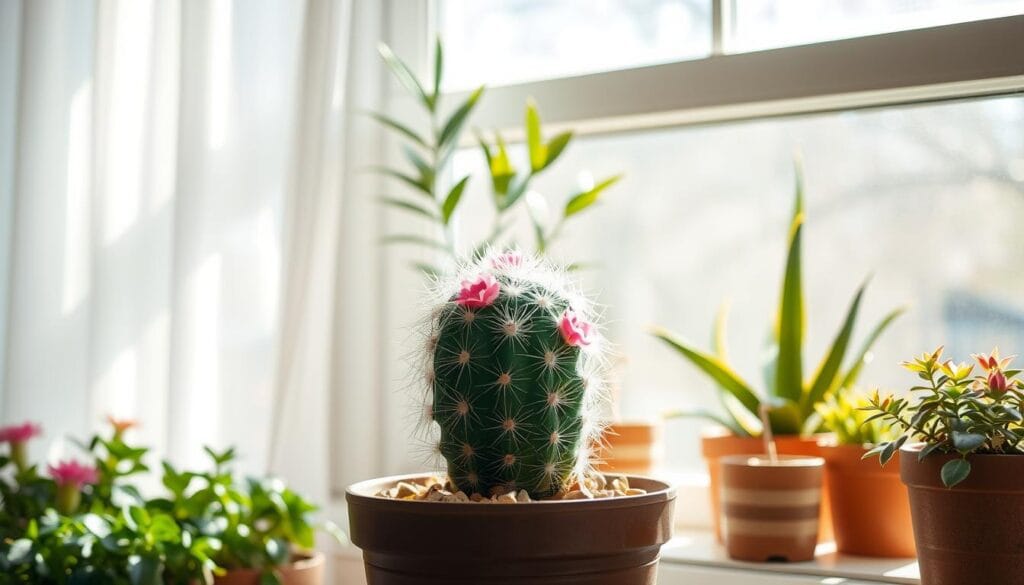
Indoor vs. Outdoor Lighting Needs
For indoor care, put your Old Lady Cactus by a south-facing window for lots of light87. If you don’t have enough natural light, LED grow lights are a great choice8. Outdoors, make sure it gets lots of sunlight but avoid too much in the afternoon.
Protecting from Excessive Sun Exposure
While your Old Lady Cactus loves sunlight, too much can hurt it. Outdoors, give it some shade in the hottest part of the day to avoid sunscald. Indoors, slowly get it used to more light when you move it to brighter places. This careful handling keeps your cactus healthy and beautiful.
“Let your Old Lady Cactus bask in the sun, but remember, even cacti can get a sunburn!”
Watering Techniques for Mammillaria hahniana
Proper watering is key for your Old Lady Cactus’s health. This drought-tolerant plant needs special care to do well indoors or outdoors.
Frequency and Amount of Watering
Mammillaria hahniana should be watered every two to four weeks. This is less often in winter3. It’s important to check the soil moisture by touch to know when to water9.
Using terracotta pots is a good idea. They help the soil dry out and prevent too much water9.
Seasonal Adjustments in Watering Routine
Changing your watering schedule with the seasons is vital. In summer, water more often and lightly. In winter, water much less because the plant is dormant9.
Local weather also affects how often you should water your Old Lady Cactus9.
Signs of Overwatering and Underwatering
Knowing when you’re watering too much or too little is important. If the soil feels spongy, you’ve watered too much. If it’s shriveled, you haven’t watered enough9.
Adjust your watering based on these signs and your environment’s temperature and humidity9.
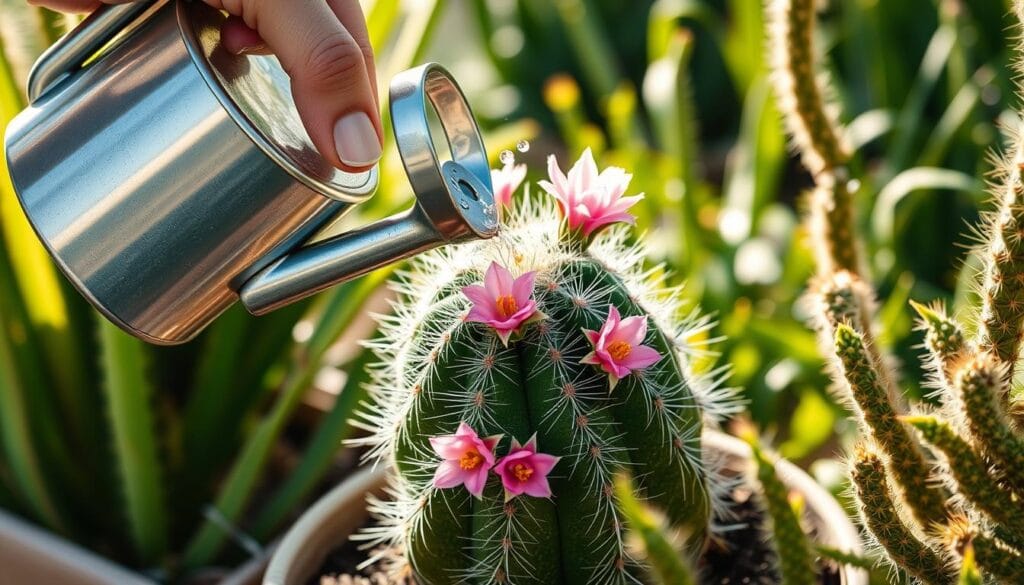
| Watering Aspect | Summer | Winter |
|---|---|---|
| Frequency | 2-4 times per month | Reduced (1-2 times per month) |
| Amount | Light to moderate | Sparse |
| Soil Condition | Allow to dry between waterings | Keep mostly dry |
Good drainage is essential to avoid overwatering and root rot in your Old Lady Cactus. Use a mix of one part sand and one part perlite for the best drainage9.
Soil and Potting Requirements
The Old Lady Cactus loves soil that drains well, just like its natural home. Mix one part topsoil, one part fine gravel or sand, and one part perlite or pumice for the best results. This mix helps prevent water from staying too long, keeping your succulent healthy.
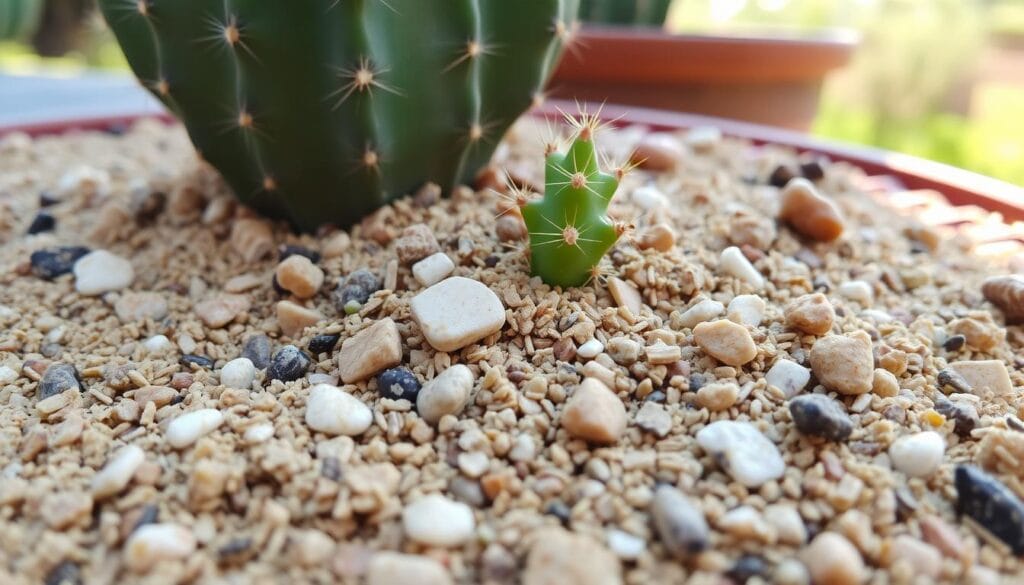
Using a commercial cactus mix with perlite is also a good choice. Make sure your pot has holes for drainage to keep water out. This simple trick is crucial for your cactus’s health.
Potting Tips for Old Lady Cactus
Repotting is important for cactus care. Do it every couple of years or when your cactus gets too big. The best time is during the warm season, when the soil is dry10. Also, remove any dead or rotting roots during repotting10.
Think about your cactus’s size when choosing a pot. Mammillaria hahniana can grow up to 3.6 inches tall and 4 inches wide10. Pick a pot that’s big enough for it to grow but still drains well.
| Soil Component | Purpose | Proportion |
|---|---|---|
| Topsoil | Provides nutrients | 1 part |
| Fine gravel/sand | Improves drainage | 1 part |
| Perlite/pumice | Enhances aeration | 1 part |
By following these tips, your Old Lady Cactus will do great. It will show off its beauty and might even bloom with dark pink to reddish-purple flowers in late winter and spring10.
Temperature and Humidity Preferences
The Old Lady Cactus is a favorite among indoor plants. It needs specific temperatures and humidity levels to thrive. Knowing these needs is key to caring for this drought-tolerant plant.
Optimal Temperature Range
The Old Lady Cactus loves warm temperatures, just like its natural home. It grows best in temperatures between 70°F and 80°F (21-27°C)1112. At night, a bit cooler is good. In winter, when it’s dormant, keep it between 45°F to 55°F (7-13°C)1213.
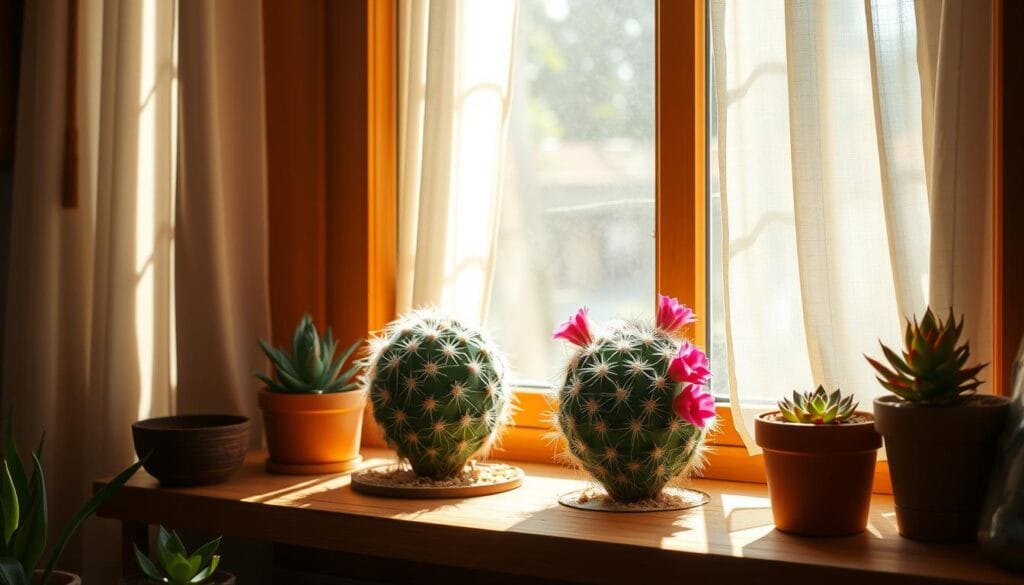
Humidity Considerations
This cactus is great for low humidity homes. It’s perfect for indoor spaces11. While it can handle dry air, a bit of humidity from watering helps it grow.
Winter Care and Dormancy Period
In winter, the Old Lady Cactus goes dormant. To help it rest:
- Water less often
- Keep it above 50°F (10°C) to avoid frost damage11
- Put it in a cooler spot
This rest is vital for its health. It can even lead to more flowers next season. Proper care during this time keeps your indoor cactus healthy.
Fertilizing Your Old Lady Cactus
The Old Lady Cactus is a unique succulent that needs special care. We’ll show you how to feed it right for a beautiful houseplant.
Spring is when your Old Lady Cactus grows the most. It’s the best time to start fertilizing it every month14. Use a balanced fertilizer with a 10-10-10 NPK ratio. This helps it bloom more than grow leaves14.
Choose between organic and synthetic fertilizers. Organic ones give nutrients slowly, while synthetic ones work fast14. Start with a weak solution and adjust as needed14.
Watch out for signs of too much fertilizer. Look for a white crust on the soil, slow growth, or brown leaves14. If you see these, wash the soil to remove extra fertilizer14.
Fertilize your cactus every 2-3 months when it’s growing11. The Old Lady Cactus can grow up to 12 inches tall. It blooms with small pink flowers as it gets older15. The right food will help it grow and bloom beautifully.
| Fertilizing Aspect | Recommendation |
|---|---|
| Frequency | Monthly during spring (growing season) |
| NPK Ratio | 10-10-10 (balanced) or 1-7-6 / 2-1-1 (flowering focus) |
| Fertilizer Type | Organic (gradual release) or Synthetic (immediate results) |
| Application Method | Diluted solution, starting at half-strength |
By following these tips, your Old Lady Cactus will get the nutrients it needs. It will thrive as a stunning succulent in your home.
Old Lady Cactus (Mammillaria hahniana) Propagation Methods
Propagating the Old Lady Cactus is a rewarding experience for any cactus hobbyist. This succulent plant offers multiple ways to expand your collection. Let’s explore the methods and timing for successful cactus propagation.
Propagation through Offsets
The easiest method for propagating Mammillaria hahniana is through offsets. These small replicas of the mother plant form around its base. Gently remove these offsets using clean, sharp tools. Allow the cut surface to callus over for a few days before planting in well-draining cactus soil.
Seed Propagation Techniques
For the patient cactus enthusiast, seed propagation is an exciting option. Collect seeds from the dried flowers of mature plants15. Sow them in a sterile, sandy mix and keep them warm and slightly moist. Germination can take several weeks, so patience is key in this method.
Best Time for Propagation
Spring is the ideal season for propagating your Old Lady Cactus. This coincides with the plant’s active growth period and flowering season. The Old Lady Cactus typically blooms in spring or early summer, producing pink, purple, white, or yellow flowers1516.
Remember, successful propagation requires the right conditions. The Old Lady Cactus thrives in temperatures between 70 to 90 degrees Fahrenheit during the day15. Ensure your propagated plants receive adequate light and minimal water to encourage strong root development.
Whether you choose offsets, seeds, or even stem cuttings, propagating the Old Lady Cactus can be a fun project for any succulent plant enthusiast16. With proper care, your propagated cacti can grow to heights of up to 12 inches, adding unique charm to your collection15.
Common Pests and Diseases
The Old Lady Cactus (Mammillaria hahniana) is usually tough but can still face problems. It grows to be 6 to 8 inches tall and needs careful care to do well16.
Pests like mealybugs and spider mites can be a problem. Look for small, cotton-like spots or tiny specks moving on your cactus. If not treated, these pests can harm the plant.
Root rot is a big worry for those who love succulents. It happens when the plant gets too much water or has poor drainage. Look for signs like color changes, unusual growth, or a soft feel. Mammillarias can easily get root rot if they get too much water17.
To avoid these issues, use soil that drains well and water right. The Old Lady Cactus likes warm temperatures, between 70-80°F, when it’s growing17. Regular checks can help spot problems early, so you can act fast.
| Common Issue | Symptoms | Prevention |
|---|---|---|
| Mealybugs | Cotton-like clusters | Regular inspections, neem oil spray |
| Spider Mites | Tiny moving specks, webbing | Increase humidity, insecticidal soap |
| Root Rot | Discoloration, squishy texture | Well-draining soil, proper watering |
Knowing about these common problems and taking good care of your cactus can help it live a long life. Some Old Lady Cacti have even lived over 50 years17.
Pruning and Maintenance Tips
Caring for your Old Lady Cactus is easy. It needs little pruning and simple upkeep. Let’s look at the best ways to keep your Mammillaria hahniana healthy and growing well.
When and How to Prune
Spring is the best time to prune your Old Lady Cactus. Fall is okay if you missed spring18. Use sharp, sterilized shears for clean cuts close to the main body18. Always wear thick gloves and safety goggles to avoid spines and debris18.
Remove damaged parts to keep the plant healthy19. Don’t water right after pruning to let it heal. Watch for signs of trouble like discoloration or wilting18.
Cleaning and Grooming Techniques
Regular checks are important for cactus care. Gently clean your Old Lady Cactus with a soft brush to remove dust. This keeps it looking good and prevents pests. Regular pest checks help catch problems early19.
Repotting Guidelines
Mammillarias like to be slightly root-bound, so they don’t need to be repotted often17. Repot every few years during the growing season19. Use a soil mix that drains well and choose the right pot size for growth19.
| Care Aspect | Frequency | Tips |
|---|---|---|
| Pruning | Annually in spring | Use sterilized tools, wear protective gear |
| Cleaning | Monthly | Soft brush for dust removal |
| Repotting | Every few years | Use well-draining soil, inspect roots |
By following these tips, your Old Lady Cactus will stay beautiful in your succulent collection. Remember, regular care is crucial for its long-term health.
Flowering Habits and Encouragement
The old lady cactus flower is truly stunning, attracting many cactus lovers. It blooms in spring and autumn, showing off its bright pink flowers with yellow anthers20.
To help it flower, we must recreate its natural environment. Cut back on watering during cooler months and winter20. This helps it form flower buds.
Light is also crucial for blooming. Place your cactus near a sunny window all year. This is believed to keep negative energy away in Feng Shui20.
Feed your cactus with a high-phosphorus fertilizer during growing seasons20. This supports its health and flower growth.
Each flower color has its own meaning. Red means love, white is for endurance, and yellow, orange, pink, and purple are for happiness and friendship20. These colors can create a beautiful ring around the plant’s top, reaching 5 3/4″ tall and 3 3/4″ wide when fully grown21.
While proper care boosts flowering chances, it’s not a sure thing. Be patient and keep up with consistent care to enjoy the old lady cactus flower.
Conclusion
The Old Lady Cactus, or Mammillaria hahniana, is a captivating succulent plant. It has won the hearts of cactus enthusiasts worldwide. Native to central Mexico, this low-maintenance beauty has become a popular houseplant. It graces homes with its unique charm and stunning blooms22.
Proper cactus care is crucial for the Old Lady Cactus to thrive. With the right conditions, this resilient plant can live for several decades. It continuously grows and adds beauty to any space22. Its annual blooming cycle, typically in spring or early summer, rewards patient gardeners with delicate pink to purple flowers2223.
We hope this guide has equipped you with the knowledge to nurture your Old Lady Cactus successfully. Remember, while it’s part of the diverse Mammillaria genus, which boasts over 200 recognized species. The Old Lady Cactus stands out with its distinctive appearance and care requirements23. By providing the right balance of light, water, and nutrients, you’ll enjoy a thriving succulent. It will bring a touch of desert charm to your home for years to come.
FAQ
What is the native habitat of the Old Lady Cactus?
What are the unique characteristics and appearance of this cactus?
How large does the Old Lady Cactus grow?
What are the ideal growing conditions for this cactus?
How much light does the Old Lady Cactus need?
How often should I water my Old Lady Cactus?
What type of soil is best for this cactus?
What are the temperature and humidity preferences for the Old Lady Cactus?
Does the Old Lady Cactus need to be fertilized?
How can I propagate the Old Lady Cactus?
What common pests and diseases should I watch out for?
How do I maintain and prune my Old Lady Cactus?
When does the Old Lady Cactus bloom?
Source Links
- What Is An Old Lady Cactus – How To Grow An Old Lady Cactus Flower
- Mammillaria (Pincushion Cactus) | North Carolina Extension Gardener Plant Toolbox
- How To Care For An Old Lady Cactus – House Digest
- Mammillaria hahniana (Old Lady Cactus, Old Lady Pincushion)
- Cafe Planta
- Mammillaria hahniana
- Old Lady Cactus Plant Care: Water, Light, Nutrients | Greg App 🌱
- My Old Lady Cactus’s Sunlight Needs
- How Often Do I Need to Water My Old Lady Cactus?
- Mammillaria hahniana (Old Lady Cactus) – World of Succulents
- The Complete Guide to Growing and Caring for Cacti as Houseplants
- Mammillaria Cacti Are Some of the Easiest Succulents You Can Grow—Here’s How
- Indoor Cacti
- Am I Starving My Old Lady Cactus? Fertilizing 101
- Cafe Planta
- Old Lady Cactus
- Grow and Care for Mammillaria Cacti: Tips for a Stunning Cactus Collection
- 🌵 How Should Old Lady Cactus Be Cut Back?
- How to Care for Mammillaria hahniana (Old Lady Cactus)
- 🌸 What Do Old Lady Cactus Flowers Mean?
- Mammillaria hahniana (Old Lady Cactus) – The Belmont Rooster
- Cafe Planta
- Exploring the Fascinating World of Popular Cactus Species


